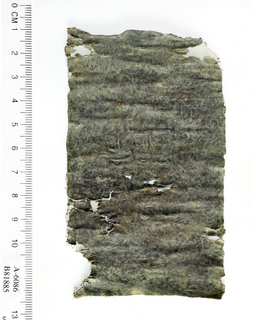Another backlog item, as reported by Israel Antiquities Authority, October 2013:
A rolled-up sheet of lead bearing a Greek inscription was recently discovered in archaeological excavations the Israel Antiquities Authority is conducting in the Giv‘ati parking lot in the City of David, funded by the ‘Ir David Fellowship. This is a curse tablet bearing a spell that was probably written by a professional sorcerer or wizard.The article A Juridical Curse from a Roman Mansion in the City of David by Doron Ben Ami, Yana Tchekhanovets, and Robert Walter Daniel was published in Zeitschrift für Papyrologie und Epigraphik, Volume 186 (2013), pp. 227-236, but doesn't yet seem to be available online for free.
According to Dr. Doron Ben-Ami and Yana Tchekhanovets, the excavation directors on behalf to the Israel Antiquities Authority, “the tablet was discovered in one of the rooms of an enormous building from the Roman period, which was excavated at the site in recent years. The building, which was constructed during the third century CE at the northern end of the City of David spur, was destroyed in the earthquake that struck the region in 363 CE, as evidenced by the many coins found amongst the collapse of its second story. A wealth of artifacts from this period was recovered from inside the ruins that were excavated in the building’s northeastern corner. Besides the lead tablet, the finds include a large amount of roof tiles stamped with the impression of the Tenth Legion that was garrisoned in the city following its destruction in 70 CE, bone and ivory objects, ceramic figurines and other finds attesting to the rich material culture of the structure’s inhabitants. Fresco remains found in the collapse are evidence of the second story walls decorated with painted floral and geometric patterns.
The lead tablet, which at the time of its discovery resembled a small narrow pipe, was sent to the laboratories of the Israel Antiquities Authority in order to be opened. After many days of toiling, Lena Kupershmidt, an IAA conservator, was the first person to set eyes on the ancient script since it was rolled up some 1,700 years ago. She needed much patience and nerves of steel to open the lead tablet because any attempt to do so quickly might have caused permanent damage to the inscription. When the tablet was finally unrolled it turned out it was in an excellent state of preservation, and included a Greek inscription that covers the entire surface of one side of the tablet, as well as part of the other side.
The tablet was sent for analysis and deciphering to Dr. Robert Daniel of the University of Cologne, Germany, a world renowned expert in the field. According to Dr. Daniel the text was written in cursive script and it was obviously not created by Kyrilla herself, rather by a professional sorcerer hired by her. The inscription invokes the curse a woman named Kyrilla wants cast on a man by the name of Iennys, probably in the wake of some legal dispute, the nature of is unclear. To this end she calls upon the help of the gods of the underworld, among them Pluto, Hermes Persephone, and even the Mesopotamian goddess Ereshkigal is asked to assist.
“I strike and strike down and nail down the tongue, the eyes, the wrath, the ire, the anger, the procrastination, the opposition of Iennys” – so says Kyrilla in one portion of the curse tablet. What we have here might be a metaphorical description of actions taken by Kyrilla designed to gain control over her legal opponent. At the same time we cannot rule out the possibility that writing the text on the tablet was literally accompanied by Kyrilla striking the image (?) of Iennys with a hammer and nails in a kind of ancient voodoo ritual.
Kyrilla hid the tablet in a place associated with Iennys and therefore the second floor room inside the ruins where the tablet was discovered was probably his residence. Alternately, a courtroom might have been situated in this corner of the Roman building where the trial of Kyrilla and Iennys was conducted. Kyrilla evidently concealed the object shortly before the structure was destroyed in the earthquake, after which the building was abandoned and never reinhabited.


.jpg)



































No comments:
Post a Comment